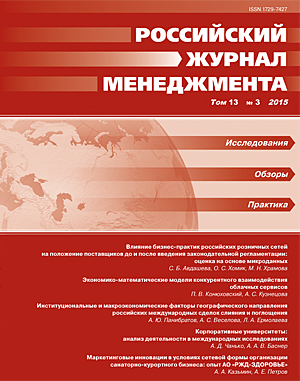Институциональные и макроэкономические факторы географического направления российских международных сделок слияния и поглощения
Аннотация
В статье исследуется влияние макроэкономических показателей страны происхождения и принимающей страны, а также институциональной дистанции между ними на выбор направления сделок слияний и поглощений (M&A) российских компаний. На основе анализа данных по сделкам, осуществленным российскими компаниями в период с 2007 по 2013 г. в 46 странах, с применением метода отрицательной биномиальной регрессии выявлено, что наиболее значимыми мотивами для их совершения являются доступ к ресурсам, доступ к стратегическим активам и технологиям, а также повышение эффективности деятельности. При этом институциональная дистанция между страной происхождения и принимающей страной оказывает как значимое прямое влияние на количество сделок, так и модерационное влияние на взаимосвязь ключевых макроэкономических показателей и количества слияний и поглощений.
Ключевые слова:
интернационализация, прямые зарубежные инвестиции, сделки слияний и поглощений, макроэкономические факторы, институциональная дистанция, Россия
Скачивания
Библиографические ссылки
Translation of references in Russian into English
Загрузки
Опубликован
Как цитировать
Выпуск
Раздел
Лицензия
Статьи журнала «Российский журнал менеджмента» находятся в открытом доступе и распространяются в соответствии с условиями Лицензионного Договора с Санкт-Петербургским государственным университетом, который бесплатно предоставляет авторам неограниченное распространение и самостоятельное архивирование.





